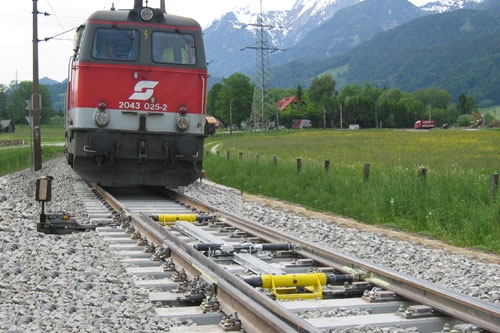SPEED, comfort, reliability, availability, and above all safety, are attributes rail customers rightly demand. As turnouts and their associated signalling equipment play a central role in railway systems, train operators and infrastructure managers are challenging suppliers to produce ever-more reliable and cost-effective equipment.
Voestalpine Hytronics has set itself the target of developing state-of-the-art signalling equipment for turnouts to produce a harmonised product, the latest development being Ecostar 4, an electro-hydraulic point machine.
The market for point machines is unusual. There are many producers of these products including most of the major signalling companies, but conversely, innovation and development is rather limited. However, customers around the world are becoming ever-more demanding and now require:
• increased reliability and availability of their assets while maintaining maximum safety levels
• lower maintenance and inspection requirements
• automatic tamping of turnouts and their equipment
• lighter weight signalling components, and
• flexibility to combine different products, for example point machines should be compatible with different interlockings.
In addition, Ecostar 4 was designed to meet the following in-house demands:
• just-in-time delivery of turnouts with point machines already installed
• a state-of-the-art technical solution
• completing our product portfolio with a point machine for the operation of external locks, and
• providing a system solution for fully-equipped plug-and-play turnouts.
Moreover, all new Hytronics products of the last few years have been subjected to a development and registration process according to Cenelec 50126/50129. Not only does this guarantee the use of up-to-date technology but, above all it fulfils the important criteria of reliability, availability, maintainability and safety (Rams), which are required from modern signalling products.
Ecostar is now in its fourth generation. Ecostar 1 was the prototype and underwent its first trials in 2006. Ecostar 2 was introduced in small numbers by various railways between 2007 and 2009 in order to gain in-track experience. Generation 3 was launched in 2009 and met the expectations of its various specifications. Now type 4 goes a step further and offers for example optional IP 67 protection or visual end position indicators.
Voestalpine Hytronics has developed several products for its new concept of a completely pre-assembled and pre-adjusted turnout which is available just-in-time. It can be supplied with point machines, lockings, power transmission systems, end position detectors and even diagnostics systems already installed. However, this requires the predominant interface for the integration of the turnout to be moved into the signalbox. The new gateway to the turnout is at the end of the supply line, right outside the point machine's electric box. Figure 1 shows the main components of Ecostar 4. Ecostar 4 has many benefits:
Ecostar 4 has many benefits:
• lightweight design of <100kg for the core unit
• rapid exchange from right hand use to left hand side installation and vice versa
• optional IP 67 protection class
• optional visual end position indicators
• installation on an external support or in a hollow steel bearer
• integration into new or existing infrastructure
• refit possibility, and
• independent interlocking integration which is compatible with four-wire and seven-wire technology using diverse detection modules with "break before make" or "make before break" contacts for different switching philosophies and interlocking requirements.
Ecostar 4 enables the existing maintenance and inspection intervals to be prolonged while improving reliability and safety due to the use of encapsulated systems, which have long-term lubrication, and the use of hydraulic systems instead of purely mechanical components that usually require intensive maintenance.
Life-cycle cost discussions very often conclude that it is not the initial capital cost of products that drives cost for several decades but expenditure on maintenance and repairing malfunctions. In this context, modern point machines can make a decisive contribution to reducing these costs.
Turnouts and retrofit point machines need to be able to adapt to various interlocking systems. During the development of Ecostar, existing interlockings around the world were studied intensively and preconditions for the machine defined. As a result, several solutions for adapting to a wide range of existing signalling cabinets have been engineered and realised. Technically, Ecostar 4 would be able to connect safely to every known interlocking solution, and so far has successfully interfaced with interlockings in a variety of applications:
• several mainline applications in Austria in combination with different types of Siemens interlockings
• Thales interlockings in various mainline installations in Austria, Bulgaria and Turkey
• Iskra interlockings in Turkey
• urban applications in Brazil with Ansaldo interlockings, and
• Eliop systems in Bulgaria and Turkey.
From an electro-technical point of view, most interface requirements are straightforward and usually very simple to realise. Nevertheless integration has to be implemented carefully to guarantee the overall safety of the interlocking.
Ecostar 4 can also be used to refit point machines on existing turnouts as it is compatible with most other lockings, power transmission and monitoring systems. This enables the customer to replace assets that are no longer state-of-the-art. For a moderate investment, the customer can gradually optimise the life-cycle cost of the turnout.
Developed, approved and produced according to Cenelec norms, Ecostar 4 represents a state-of-the-art system for vignol-rail turnouts of any design which is not only ready to operate existing turnouts, but also those of the future.

